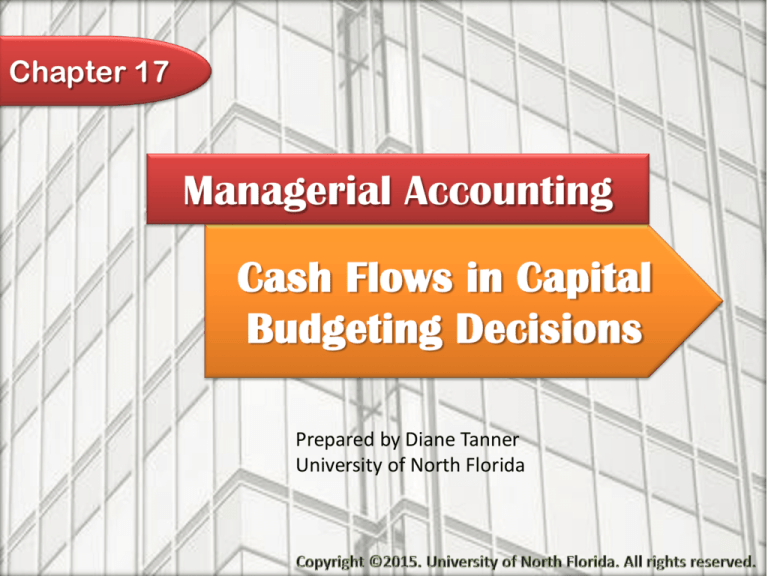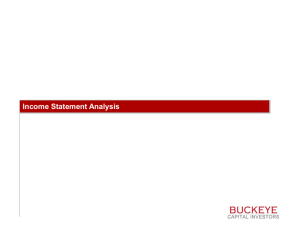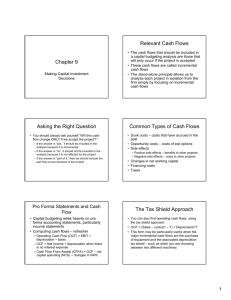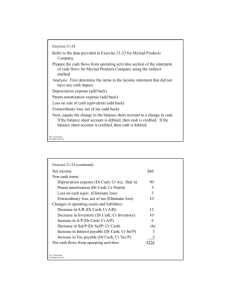Cash Flows in Capital Budgeting Decisions
advertisement

Chapter 17 Managerial Accounting Cash Flows in Capital Budgeting Decisions Prepared by Diane Tanner University of North Florida Cash Flows in Capital Budgeting • Only incremental amounts are considered • Two categories of cash flows • Operating activities • Activities which occur as a result of business operations during the year • Found on the income statement • Investing activities • Acquisition of long-term assets • Cash received from sale of long-term assets Investing Cash Flows in Capital Budgeting Two primary investing cash flows Purchase of investment assets at year 0 Cash from the sale of long-term assets Salvage value is an expected cash flow If sold at the end of the useful life for the salvage value, no gain or loss will occur Accrual Vs. Cash Basis Operations can be based on: Cash Basis Provides: • Cash inflows • Cash outflows Accrual Basis Provides: • Amounts earned • Amounts incurred An indicator of real profits Capital Budgeting Assumptions Assume all revenue is received in the period earned i.e., Revenue = cash inflows Assume that all expenses are paid in the same period incurred i.e., All expenses = cash outflows Non-cash items that are never paid nor received Depreciation expense Amortization expense Gains on disposal of long-term assets Losses on disposal of long-term assets Indirect Method of Calculating Operating Cash Flows Begin with accrual basis net income Remove items that are not cash flows Add Noncash expenses (e.g., depreciation, amortization) Losses from disposition of long-term assets Subtract Gains from disposition of long-term assets Note that basic accruals and deferrals need not be adjusted because of the assumptions made in capital budgeting. Direct Method of Calculating Operating Cash Flows Also known as the shield method Calculating cash basis net income Omit all non-cash amounts Income taxes will be based on cash basis income before taxes Add/subtract the tax shields Tax Shields Tax savings/costs due to reporting expenses that have no cash flow effect Four common tax shields Depreciation tax shield Depreciation expense × tax rate Amortization tax shield Amortization expense × tax rate Loss tax shield Loss on disposal × tax rate Gain negative tax shield Gain on disposal × tax rate Tax savings due to reporting an expense that does not use cash Additional tax cost due to reporting a revenue that does not generate cash Depreciation tax shield = Depreciation expense x income tax rate Operating Cash Flows – Indirect Method FiCo is deciding whether to purchase equipment with a cost of $74,000, an estimated residual value of $6,000, and an estimated life of 8 years. FinTru predicts the equipment will reduce annual payroll costs to $360,000 from the current level of $423,000. Cash operating expenses related to the new equipment are expected to be $41,200 per year. FiCo’s cost of capital is 7.4%, its required rate of return is 8.8%, and its income tax rate is 31%. Calculate annual incremental operating cash flows. Incremental payroll cost savings ($423,000 - $360,000) Incremental cash operating expenses Incremental depreciation ($74,000 - $6,000)/8 Income before taxes Income taxes expense (31% x $13,300) Incremental net income Add depreciation Operating cash flows $63,000 (41,200) (8,500) 13,300 (4,123) 9,177 8,500 $17,677 9 Operating Cash Flows – Shield Method 10 FiCo is deciding whether to purchase equipment with a cost of $74,000, an estimated residual value of $6,000, and an estimated life of 8 years. FinTru predicts the equipment will reduce annual payroll costs to $360,000 from the current level of $423,000. Cash operating expenses related to the new equipment are expected to be $41,200 per year. FiCo’s cost of capital is 7.4%, its required rate of return is 8.8%, and its income tax rate is 31%. Calculate annual incremental operating cash flows. Incremental payroll cost savings Incremental cash operating expenses Incremental depreciation Income before taxes Income taxes expense Incremental net income Add depreciation Operating cash flows $63,000 $63,000 (41,200) (41,200) (8,500) -13,300 21,800 (4,123) (6,758) 9,177 15,042 Cash basis income 2,635 8,500 $17,677 $17,677 Depreciation tax shield = $8,500 x 31% = $2,635 Tax savings: $6,758 - $4,123 = $2,635 The End 11





